I have a treat today for all of you do-it-yourself types. Before I inflict another set of poorly-drawn, even more poorly conceived technical schemata on you, a brief disclaimer and explanation is perhaps in order.
Now, for the disclaimer: this item is contraband, and will be taken if detected. In addition, the fabrication of this unit will require items which are also contraband, so if you get busted with this, you are on your own. It is a small item, though, and if you cant figure out how to hide something of these dimensions, you probably ought to go ahead and turn in your convict card. At any rate, enjoy!
Comrade Thomas’ Ad-Seg Multi-Outlet
First, some photos of the finished product:
To build your own, you will need the following items:
- 1 packet of Crescent art boards ($4.00 for two at current prices)
- 1 aluminum soda can
- 1 piece aesthetically pleasing magazine paper, for cover
- glue
- tape ( I prefer packing tape, but use whatever you can get)
- razor blade
- 1 regulation red “onion-style” property bag
Then, you will need to cut out the following pieces from an aluminum soda can:
Note: Soda cans are actually very easy to work with. You don’t even really need a blade to cut them, if you don’t have one handy. Simply press the nub of a pen down into the can and lay a track. Then flex the can along the indention to snap the can. I usually remove the tops and bottoms of the can first, which leaves you with a nice, rectangular sheet of metal to work with. If you are careful and precise with your measurements, you will be able to get both side plates and both prongs out of a single can. Straight edges can be easily produced by merely folding the aluminum back and forth a few times, which causes it to split perfectly. Don’t cut yourself, though I think it would actually be pretty difficult to manage that even if you wanted to.
Once you have the aluminum pieces cut to size, you will need to prepare them for use. All soda cans have a sort of waxy coating bound to the metal, which prevents conductivity. To remove this, simply use a razor blade to scrape the surface of both sides of each piece. Make sure you take your time and do this well, because if you leave even the thinnest patina of coating in place, the entire project is going to be a waste of time, and you will probably sit there for an hour like a dumbass trying to figure out why metal suddenly decided it did not want to obey the laws of physics. Not that I did that. It was more like two hours.
When you have finished with this, take the two aluminum side plates and fold each along the long axis, as indicated in the previous drawing. Set these aside. Building the prongs is the most difficult portion of the outlet, and you may have to attempt them a few times before you get the hang of it. Basically, all you are doing is folding the metal end over end, until it is converted from a sheet into a solid, thin strip. I usually fold mine 7 or 8 times, but it doesn’t really matter so long as the total width of each prong is not greater than 5mm. Wall sockets tend to vary a little in dimensions, so making the perfect fit is going to require you to customize the exact procedure here, so that the outlet fits snugly into the wall. The following diagram should make the prong folding process a bit clearer:
All the pieces are now ready for assembly! To begin, select seven (of the original nine) main board pieces, and sandwich them together, like this:
Now, take the two aluminum plate pieces, and press them against the boards. To continue the sandwich analogy, the Crescent art boards are slices of smoked turkey (mmm…), and the aluminum plates are slices of artisinal multi-grain bread. (Damnit, now I have gone and made myself hungry.) It should look something like this:
To hold the core and the aluminum plates together, we next apply the wraps. I always begin with the bottom wrap, and build up from there. I recommend this tactic, as it will help you make sure that the holes for the prongs are large enough to accommodate all sorts of appliances. To attach the bottom wrap to the core, first touch a dab of glue to the center of the wrap, and then lay it across the core. Once this is in place, you will need to use some twine to secure it. I use strands cut out of the TDCJ property bags, shown here:
Once the bottom wrap is fixed in place, it should look something like this:
After the bottom wrap is in place; the rest is simple: in sequence, apply one “square” piece directly above the wrap with glue. Above this, attach a regular wrap in the same fashion as the bottom one. Then another square, etc, until you have the following configuration:
Note that the gap between the two top wraps is left open; this is where we will attach the prongs. I use four or five pieces of twine attached end to end for this. Once attached, the outlet should look something like the following photos:
The green pieces .are the back sides of the art boards. The red is the twine. The silver is the aluminum plates showing through. In some of these photos you can see where an appliance is inserted.
For the next step, take the last two main boards and affix them to the core, using tape, as seen here:
The final step involves making a cover, so that you wont accidentally shock yourself every time you plug something in. Unless you are into that, I guess. I use magazine paper for this, coating it in a few strips of packing tape for durability and moisture protection. The cover measures somewhere in the neighborhood of 120mm by 125mm. It is a snap to then measure out the holes for the prongs and the plugs. I use a template for this, such as you can see here:

That’s it! As you can see, it works exactly as it should when assembled correctly:
By way of getting in a cheap shot, let me close with a quick point: the current budget woes are going to mean the elimination of a virtually all “programs” within the TDCJ. Texas has never been known as a progressive place, so there were not exactly a lot of these before confronting Perry’s mess. Pretty much all of the ones that did exist are now on the chopping block: Project RIO (designed to re-integrate prisoners into the job market so that they don’t go back to old ways), the chaplaincy (which was worthless anyways – good riddance), breakfast on weekends, and most notably, the Windham School District, which handles all GED and vocational training courses in the entire system. There is no money, you claim, for anything. Yet, you keep me in a cell all day, twiddling my thumbs. I built a fully-functional electrical appliance out of practically nothing. Why on earth don’t you put me to some use? I could pay for the costs of my imprisonment easily if you put me in a machine shop or set me to installing solar panels on the roofs of these buildings. It is difficult to believe all of the end-times talk coming out of Austin when these prisons are run so inefficiently. Why don’t you run them like socially-oriented business? That’s what you love so much, isn’t it, Governor-for-life Perry? Don’t you believe that Big Business is the answer to every question? Let me actually work to repay the society I harmed. I am willing. Obviously, I am capable. Beyond all of that, I am waiting.
© Copyright 2011 by Thomas Bartlett Whitaker. All rights reserved
























No Comments
Ilaria
May 3, 2011 at 7:05 pm… "Arbeit macht frei."
Admiral_John
April 26, 2011 at 7:23 pmI'm a bit confused… as much as I enjoy reading this blog and enjoyed reading this post, what he's talking about making is, by his own admission, contraband and requires contraband to make. By the regulations of the prison, this is understandably against the rules and he's very obviously offended that his original message was confiscated. And in reading the form indicating the letter was confiscated it very clearly indicates "refused to sign."
He broke a rule here, and was caught. Sorry, that's not thievery on the part of TDOJ. That's part of being in prison.